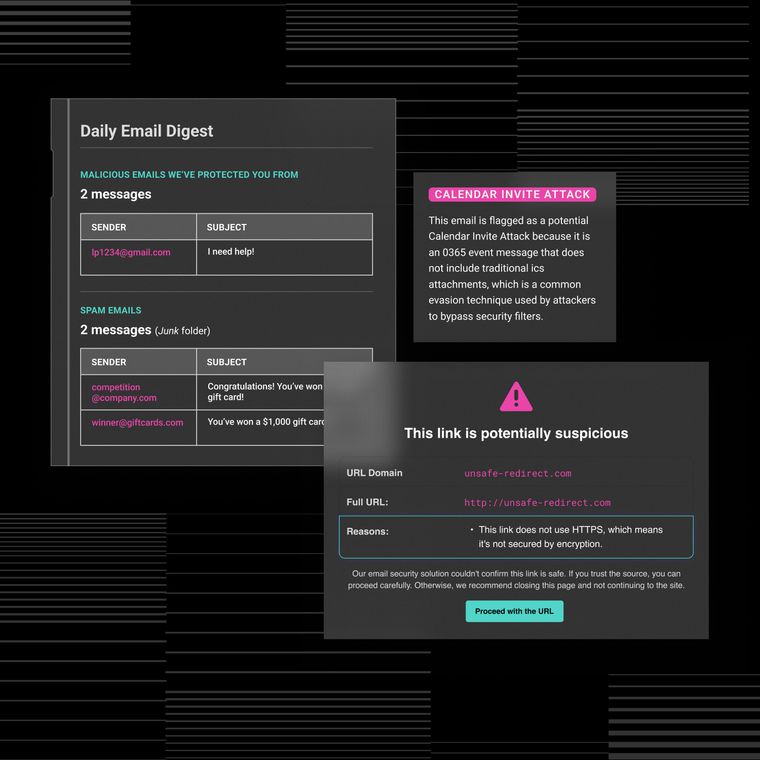Top 5 Costly Email Security Threats Most SMBs Overlook
Identify the email security threats most SMBs overlook—and learn how to prevent costly breaches.
August 7, 2025

For small and midsize businesses, email remains one of the most targeted and most underestimated attack surfaces. Business email compromise alone can cost over $125,000 per incident, and phishing, spoofing, and payload-free attacks continue to slip past traditional filters.
These threats often don’t rely on malware or suspicious links, but instead mimic trusted senders, exploit vendor relationships, and use conversational language to deceive recipients.
What makes these attacks especially dangerous is their subtlety. They bypass defenses by manipulating trust, not technology, turning everyday business communications into tools for fraud. From impersonated executives to hijacked supplier emails, the most damaging threats are the ones that look legitimate.
The sections that follow outline five critical email threats frequently overlooked by SMBs, along with the behavioral indicators and controls necessary to detect and mitigate them before they result in financial or reputational harm.
1. Business Email Compromise (BEC) That Looks Internal
BEC attacks that appear to originate from within the organization use stolen or spoofed identities to redirect funds or extract sensitive data before detection quietly.
How Attackers Blend In
With their research on org charts, workflows, and writing styles, attackers often gain access to executive or finance accounts through phishing or brute-force tactics. Once inside, they send messages from legitimate "@yourcompany.com" addresses that pass authentication checks like SPF, DKIM, and DMARC. These emails blend seamlessly into existing conversations, brief, urgent requests like "Can you send this wire before noon?" that prompt quick, unquestioned action.
Because there’s no malware involved, traditional detection fails. Behavioral AI, however, can identify subtle shifts in tone, timing, and peer-to-peer patterns to flag compromised accounts early.
Impact and Mitigation Strategies
BEC attacks cost SMBs significantly, damaging finances, vendor trust, and data privacy. Recovery can involve legal, operational, and reputational fallout.
Here’s what you need to do to mitigate the risks:
Enforce MFA across all cloud and email accounts.
Require dual approval for financial transactions and vendor banking changes.
Confirm sensitive requests through separate channels, like phone verification.
Continuously monitor for behavioral anomalies such as unusual access patterns, spending activity, or new recipient interactions.
These measures create essential friction, making it harder for attackers to operate undetected.
2. Vendor Email Compromise (VEC)
Vendor Email Compromise (VEC) occurs when attackers take control of trusted supplier accounts and insert fraudulent payment instructions into legitimate conversations. While the total financial impact is difficult to measure, these attacks are increasingly widespread and highly effective.
How VEC Slips Past Your Defenses
Once attackers gain access to a vendor’s email account, they monitor correspondence and wait for the right moment, typically when a payment is due. They then insert fake invoices or banking changes into ongoing threads.
These messages often pass SPF, DKIM, and DMARC checks, use familiar formatting, and reference known purchase orders or signatures, making them difficult to spot. Since the emails come from real domains and contain no malware or suspicious links, traditional secure email gateways fail to block them.
Safeguards: Verification Over Blind Trust
Protect against VEC by requiring verbal confirmation for any changes to payment details, regardless of email authenticity.
Start by maintaining a vetted vendor contact list with confirmed phone numbers and enforce multi-step approval for high-value transactions. Additionally, leverage behavioral AI to detect deviations in supplier communication patterns, such as off-hours invoices or logins from unusual IPs. Next, formalize out-of-band verification protocols to ensure changes are legitimate.
These steps introduce necessary friction, helping prevent fraud while supporting everyday business workflows.
3. Evasive Payload-Free Phishing
Payload-free phishing bypasses legacy filters by eliminating detectable malware and suspicious links, instead weaponizing social engineering to extract credentials and financial information.
How Attackers Evade Traditional Filters
These campaigns arrive as routine messages without attachments or hyperlinks for scanners to flag. Attackers embed URLs inside QR codes, conceal scripts in benign SVG or HTML files, or host lure pages on trusted cloud services. Others deploy conversational emails that prompt replies or phone calls, keeping malicious activity completely out of band.
Generative AI personalizes each message, randomizing wording, subject lines, and sender personas so signature-based tools detect no common patterns across thousands of messages. Since these schemes omit static indicators, malicious hashes, blacklisted domains, or suspicious macros, signature and sandbox defenses remain silent while employees engage with the content.
Business Impact and Modern Detection
Once employees respond, attackers harvest login credentials, infiltrate SaaS applications, and launch internal phishing or fraud campaigns. What’s dangerous is that even a single missed lure can still escalate into account takeover, data exfiltration, or ransomware deployment.
Behavioral AI disrupts this cycle by modeling standard communication patterns and flagging anomalies. These anomalies can be unexpected QR codes, sudden wire transfer requests, or language that deviates from a sender's established tone. Intent-based detection surfaces these quiet threats before users engage, focusing on behavioral patterns rather than static artifacts.
Remember, legacy controls cannot block what they cannot detect, making intent-based behavioral analysis essential for visibility into social engineering attacks hiding beneath legitimate-looking communications.
4. Lookalike Domains and Display-Name Spoofing
Lookalike domains and display-name spoofing prey on the split-second trust you place in familiar names, rerouting money or credentials before anyone notices. Here’s what you need to look for:
Attackers register "amaz0n.com" or "rnicrosoft.com," swap a Latin "a" for a Cyrillic "а," or pick a new top-level domain that feels legitimate. These homograph phishing attacks use near-invisible Unicode swaps to create URLs that appear legitimate yet deliver you to credential-harvesting pages instead of the real site.
Display-name spoofing is even simpler: a message from "PayPal Support" <attacker@gmail.com> lands in an inbox that only shows the name, not the address. Because many mobile clients hide the full sender field, the deception survives initial scrutiny, especially when paired with urgent language about invoices or account suspension.
Once trust is won, consequences escalate quickly, including misdirected payments, leaked credentials, and compliance violations that drain both revenue and reputation. Firms that fall for a single forged domain can spend weeks untangling fraudulent transfers and reassuring partners who now question their security posture.
To combat these incidents, red-flag suspicious emails by confirming exact domain spelling, including characters and top-level domain, verifying that reply-to and return-path fields match the display name, and checking any "urgent" financial request through a secondary channel.
Natural-language and computer-vision models now spot these subtle anomalies in real-time, providing behavioral shields that static filters cannot match. This technology represents the difference between reactive damage control and proactive threat prevention.
5. Compromised Internal Accounts (Account Takeover)
Account takeovers are among the most dangerous and difficult-to-detect email threats. Once attackers gain access to a legitimate employee’s mailbox, every message they send appears authentic, mimicking the employee’s usual tone and behavior.
These compromises often begin with credential phishing or password-spray attacks, especially against users without multi-factor authentication. Once inside, attackers monitor conversations, launch internal phishing, request sensitive files, or initiate unauthorized transfers, all from a valid account. Traditional filters rarely flag this activity, and colleagues may not question familiar messages.
SMBs are especially at risk due to weak password practices, reused credentials, limited behavioral monitoring, and a lack of conditional access controls. Suspicious logins, such as impossible travel or strange device fingerprints, often go unnoticed.
To reduce risk, follow these steps:
Enforce MFA across all cloud and email accounts
Regularly audit OAuth permissions and mailbox activity
Set up flags for anomalies like unusual sending volume or data access
Use AI to baseline normal behavior and alert on deviations
Combining authentication, monitoring, and behavioral AI makes it far harder for attackers to operate undetected inside your organization.
How Abnormal AI Helps SMBs Stay Ahead of Subtle Email Threats
Behavioral AI closes the gap legacy filters leave when relationship-based attacks slip through. BEC, VEC, payload-free phishing, lookalike domains, and account takeovers exploit trust rather than obvious malware.
Static defenses, including those that only score messages for bad links, attachments, or sender reputation, are increasingly bypassed by modern relationship-based attacks, which now drive a substantial share of email-related breaches.
Abnormal approaches the problem differently: it builds a dynamic model of every user, vendor, and workflow in your environment, then flags deviations that humans and rule-based tools miss. This behavioral layer delivers three core advantages: API-level deployment integrates in minutes, ingests historical mail, and starts baselining without MX changes or downtime.
Also, the behavioral graph intelligence maps who typically email whom, how they write, and when payments occur, so a single anomalous request stands out. Precision detection drives low false-positive rates, letting you focus on real threats instead of tuning rules.
Pair that context-aware analysis with fundamentals like multi-factor authentication, dual-approval for payments, and vendor verification to gain defense depth sized for an SMB budget. The result: you spot the next subtle email scam before funds move or credentials leak.
Learn more about how Abnormal can help by booking a personalized demo.
Related Posts
Get the Latest Email Security Insights
Subscribe to our newsletter to receive updates on the latest attacks and new trends in the email threat landscape.


